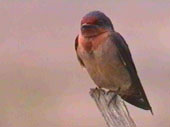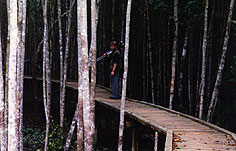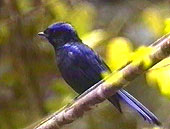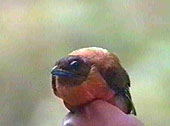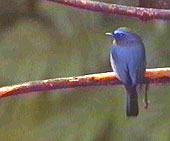Birding
trip to Malaysia 1997

by
Tom and Marie Tarrant
During September 1997 we returned to the
UK with a two-week stopover in Malaysia and managed to visit 3 main sites,
Kuala Selangor, Bukit Fraser (Fraser's Hill) and Taman Negara; This is
a brief description of the wildlife seen during that period. If you have
any questions or require more detailed information please contact us by
email
Why not visit our Homepage,take
a look at our return stop-over in Goa,
India
Arrival
We arrived in Kuala Lumpur on September 4
spending the night there, the following day we hired a car from Mayflower
Car Hire for six days at approx M$100/day and drove to Kuala Selangor.
At KS we booked into the rest-house at Bukit Melawati for M$40/night.
Unfortunately the smog from Kalimantan
and Sumatra was evident here and was to be present for most of the two
weeks we spent in Malaysia.
Kuala Selangor
The first evening at Bukit Melawati brought
Crested Goshawk(Accipiter trivirgatus), Drongo Cuckoo(Surniculus
lugubris) and Large-tailed Nightjar (Caprimulgus macrurus).
In the morning we walked down to KS Nature Reserve and Marie found a family
of Smooth-clawed Otters at play; something I was hoping to see on a previous
trip.
|
Track leading to 'scrapes'
in Kuala Selangor NR |
Pacific Swallow
(Hirundo tahitica)
|
The birding here was good although the
only unusual sighting was a Kingfisher showing a blue tone more reminiscent
of Blue-eared (Alcedo meninting) than Common (A. atthis)
which were very common. We enquired about this to one of the park staff
who did not think Blue-eared was a possibility. Sadly, there was
no sign of the Mangrove Pitta (Pitta megarhyncha) that I had observed
in August 1994 near the southern tower-hide.
At Bukit Melawati we had lunch and I
found a rather pretty female Yellow-rumped Flycatcher (Ficedula zanthopygia)
perched near the car-park.
Later we drove to Tanjong Karang, an
area of rice cultivation that had a large number of migrant waders in 1994,
however the rice seemed to have reached a substantial height and Common
Sandpipers (Actitis hypoleucos) were the only waders seen.
With patience Cinnamon Bitterns (Ixobrychus cinnamomeus) appeared
to be plentiful but we saw several workers spraying pest or herbicides
on the rice with 'fogging' machines.
In the evening we drove to Kuantan and
took a boat-trip down the river to see the famous 'fireflies' or Kilip-kilip,
this was very tranquil and an excellent trip but very little other wildlife
was recorded.
Bukit Fraser (Fraser's Hill)
On Saturday September 7 we set off for Fraser's
Hill and reached there in the afternoon. We checked into a rather expensive
chalet-style room for one night as we were unable to stay at the Gap Rest-House
until the following evening. We explored the Telekom loop road in the late
afternoon but were dismayed to see much 'development' proceeding, however
we caught up with some interesting birds at the eastern end such as Grey-chinned
Minivet (Pericrocotus solaris), Long-tailed Broadbill (Psarisomus
dalhousiae) and Black-and-Crimson Oriole (Oriolus cruentus)
|
Golden-throated Barbet
(Megalaima franklinii) |
Mangrove
Boardwalk
|
The following day we checked into the
Gap Rest-House (much better value than the chalet at Temerloh) and returned
to Fraser's Hill where we were fortunate enough to meet Mr Durai, an excellent
birder who helps run the new nature centre near the mosque, he invited
us to accompany him the next day on a birdwalk along the soon-to-be opened
new road which will replace the old windy one from the Gap.
Later we walked up to the Seri Berkat
Rest-House where we found a fruiting-tree, this seemed to be a magnet for
various frugivorous species such as Mountain Imperial Pigeon (Ducula
badia), Chestnut-Capped and Crowned Laughing-Thrush (Garrulax mitratus
and erythrocephalus), Black-browed and Golden-throated Barbet(Megalaima
oorti and franklinii) (which according to Durai were well above their
usual altitude) we managed to obtain some reasonable video-footage and
photographs of these. Unfortunately on returning the next day there
were virtually no birds present.
|
The 'Gap' Rest-House |
Large Niltava
(Niltava grandis)
|
We also visited the famous (or infamous!)
Fraser's Hill Tip, which can yield some excellent insectivorous species
but also subjects your respiratory system to toxic smoke and all manner
of unpleasant smells. Bronzed and Lesser Racket-tailed Drongos (Dicrurus
aeneus and remifer) Hill Blue Flycatcher (Cyornis banyumas)
Crested Serpent-Eagle (Spilornis cheela) and Golden Babbler (Stachyris
chrysea) are some of the species seen on this trip and Blue Nuthatch
(Sitta azurea) were seen there 3 years before.
After lunch, we took a walk along the
Abu Suradi Trail near the mosque and although it was very quiet we came
across a superb Bay Woodpecker (Blythipicus pyrrhotis) displaying
along a fallen log.
Later we went out with Durai for
the walk along the new access road, with a group of other interested locals
and tourists, one of the first species seen was an incredible
Blyth's Hawk-Eagle (Spizaetus alboniger) which soared above us for
some time against a clear blue sky; After all the smog on preceding days,
a real highlight.
The road development has caused much
disturbance to the surrounding forest but it did enable us to get good
views of White-handed Gibbon and Sultan Tit (Melanochlora sultanea)
Green Magpie (Cissa chinensis) and Streaked Wren-Babbler (Napothera
brevicaudata) were glimpsed briefly in thick cover.
We returned to the Gap in the afternoon
and waited for dusk and the arrival of the Malaysian Eared-Nightjars (Eurostopodus
temmincki) which I had seen and heard well there in 1994, they appeared
briefly around 7.30pm but were difficult to see due to the smog which had
consolidated during the day. Their call is noted as "quick-three-beers"
and is easy to remember once heard.
The next day we were regaled with the
calls or songs of White-handed Gibbons, which so impressed Marie that she
tape-recorded them; they are certainly easier to hear than see.
I decided to try filming around the Gap,
and had success with a family party of Black Laughing-thrush (Garrulax
lugubris) They looked rather like glove-puppets as they displayed to
each other; In the same area I was fortunate to see my first Crested Jay
(Platylophus galericulatus) and Grey-throated Babblers (Stachyris
nigriceps)
After about 08.30am the area became busy
with traffic, probably working on the new Fraser's Hill access road so
we decided to cut our losses and pack up and leave for KL. On the road
to Kuala Kuba Bahru we had excellent views of a perched Crested Serpent-Eagle
(Spilornis cheela) and Whiskered Tree-swift (Hemiprocne comata)
|
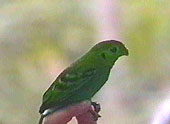
|
|
|
Green Broadbill (Calyptomena
viridis) |
Scarlet-rumped
Trogon(Harpactes duvaucelli)
|
Taman Negara
We organized our transport to Taman Negara
from the Malaysian Tourist Information Centre on Jalan Ampang in Kuala
Lumpur. We were picked up by minibus around 8am from the Hotel Malaya and
taken to the Hotel Istana where we boarded a luxury coach which took us
to Tembeling to meet the ferry for the boat-trip to Taman Negara. At the
bus terminal there are a couple of cafes where one can buy refreshments
for the trip and book accomodation in the resort or in the kampung across
the river. The speed-boat left at 2pm and took approx 3 hours to
arrive at Kuala Tahan, the headquarters of Taman Negara. We had decided
to stay at the Agoh Chalets at Kuala Tahan, these were cheap at M$30 for
a double-room per night but were very basic although they did supply an
electric fan. (the cheapest rooms in the resort were M$125 per night)
Conditions at TN were far from perfect,
the sun was a red disc at midday due to the smog and incredibly humid (although
drought conditions were prevalent...this had it's advantages as we didn't
see a leech until it rained on our penultimate day).
Our first days birding was excellent,
the variety was enormous, many different Broadbills, Babblers and Bulbuls,
Woodpeckers, Malkohas and Flycatchers although we found it very energy-draining.
I continued birding at lunch-time through the rainforest to the canopy-walk
whilst Marie returned to the chalet for a siesta. On the way I saw little
but a surprise tick on a vine was a Rufous Piculet (Sasia abnormis)
and later I heard an incredible cacophony coming from across the river,
suspecting the impending approach of unknown hornbills I prepared to pack
up my video-camera. The noisy shapes passed over and appeared to land on
large trees behind me on Bukit Teresek. The ramble up the hill initially
appeared to be a fairly gentle climb but soon turned into something resembling
the 'Kokoda Trail' and after about an hour under the trees trying to get
a glimpse I gave up. The following morning Marie and I tried again in the
same spot and with cooler conditions were treated to astonishing views
of Rhinoceros Hornbill (Buceros rhinoceros) Unfortunately the only
other hornbill seen was a Malaysian Pied Hornbill (Anthracoceros albirostris)
near the HQ early the following morning. In the same area we heard the
"kow-wow" call of the male Great Argus (Argusianus argus) but no
views were had.
|
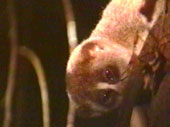
|
|
|
Slow Loris |
Hill Blue Flycatcher(Cyornis
banyumas)
|
Spot-lighting was not very fruitful bird-wise
but we did see Mouse deer at close quarters and a Slow Loris which was
so close to enable video to be taken.
On one day I came across some people
engaged in 'banding' and saw three species not seen in the wild, Oriental
Dwarf Kingfisher(Ceyx erithacus) Scarlet-rumed Trogon(Harpactes
duvaucelli) and Grey-headed Babbler(Stachyris poliocephalus)
Another trip we took was a speed-boat
up to the 'Cascades' at Lata Berkoh, Unfortunately we missed Masked Finfoot(Heliopais
personata) which is occasionally seen in the early-morning but saw
our only Chestnut-naped Forktail (Enicurus ruficapillus) and Blue-banded
Kingfisher (Alcedo euryzonia) for the trip.
Overall the six days at Taman Negara
went very fast but the birding could be quite variable and the smog made
observation difficult at times....on one occasion I saw a probable Bat
Hawk(Machaerhamphus alcinus) which I think I could have identified
positively under normal conditions, and the Great Slaty Woodpecker (Mulleripicus
pulverulentus) was a similar story!
Thanks to everyone who helped us with
this trip, especially those who sent us information through email and internet
links, If anyone reading this is planning a trip to Malaysia please contact
Mr Durai at the Nature Education Centre c/o WWF Office Bungalow Bentong
49000 Bukit Fraser (Fraser's Hill) Pahang Darul Makmur, Malaysia. (There
is an email address but I'm not sure if it's current, try: dure@rocket.mail.com.my)
I've put some links to Malaysian sites
at the end of this page please take a look!
Home
Species
List
Click
here to see a list of Bird and Mammal species seen
Number
of visitors to this page since it's inception 15 January 1998
